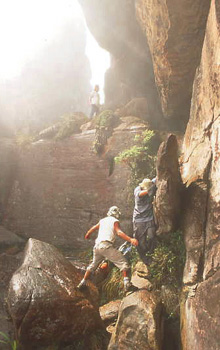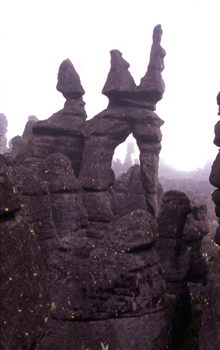By David Brandt-Erichsen
Included in a list of the world's most remote and little explored places are the isolated high sandstone mesas of south-central and southeastern Venezuela known as tepuis. There are over a hundred of these tepuis rising some 4,000 feet above the surrounding terrain and flanked on all sides by 1,000 to 2,000 foot cliffs. The world's highest waterfall, 3,200-foot Angel Falls, cascades off the side of one of these tepuis. The isolated mesa tops give evolutionary rise to plant and animal species not found anywhere else in the world (even on other tepuis). Some of the tepuis have never been explored. One of the few references on tepuis is a National Geographic article in the May 1989 issue. It includes some arch photographs.
The remote and forbidding tepuis were a natural magnet for Tucson, Arizona's, world-wide explorer, adventurer, canyoneer and publisher, Richard D. Fisher. Fisher has published a series of books titled Earth's Mystical Grand Canyons covering areas as diverse as Mexico, Bolivia, Tibet, China and Australia. He is credited with a number of first descents, and his explorations sometimes garner him some arches as well. He is credited with the discovery, in 1998, of Australia's “Rainbow Bridge” in a remote section of the Bungle Bungle Range in Purnululu National Park in northwestern Australia.
Some of the Venezuelan tepuis are known to harbor a few natural arches, but the Kekenan tepui is unique in harboring many hundreds if not thousands of arches, albeit small ones. Richard picked the Kekenan tepui as his destination because it is one of the most rarely visited, has many diverse features, and is perhaps the most “bizarre” of the tepuis. It is officially closed to visitation except by special permit which Richard was able to obtain because of his publishing background. Kekenan tepui is also known as Cuquenan and is sometimes known as Metawi tepui.
Richard and a partner took a 30-minute helicopter flight from Santa Elena to a concrete landing pad that was built in the middle of the tepui (the only sign of civilization there). They then headed to a place near the eastern edge called “The Hotel” because it is the only camping spot on the tepui which offers a natural shelter from the frequent rain. The Hotel is actually a large natural arch about 30 feet wide, 80 to 100 feet high, and 80 to 100 feet deep. They spent five days here in January 2002. Although this is the dry season (with moderate temperatures), it still rained every day, usually for an hour or two in the afternoon and then most of the night. On three of the five days they also had periods of white-outs due to the misty clouds, which made navigation difficult.


The Hotel proved to have a major inconvenience, however. It was located far from the most interesting things to see on the tepui, requiring a difficult two hour hike each way each day. The tepui is about two miles wide east to west and about six miles long north to south. Two-thousand foot Cuquenan Falls plunges off the southern tip of the tepui. They were not able to explore the northern and southern sections in the time allotted but had to stick to the central section. In the central area is a large crevice ("La Grande Grite"), large enough to fly a helicopter into. Another interesting feature is the "Valley of the Robots" which is riddled with person-sized standing rocks in great variety. There are a tremendous number of balanced rocks. One of them Richard described as follows: Imagine a rock twice the size of Delicate Arch but with one "foot" missing so it is standing on just one leg but arcing over toward the ground, kind of like a steam shovel. What is hard to imagine is what keeps it standing.
The area containing the labyrinth of arches was on the western side of the tepui, encompassing about a square mile. There was only time to explore a small portion. Of particular interest was what Richard calls the “Chinese Pagoda,” although a previous visitor had bestowed the unofficial name “The Guardian of Cuquenan” (Figure 1). Its base is riddled with vertical openings, and it is amazing how it is able to keep standing. Richard estimates that the total number of arches must be in the thousands. There were numerous vantages where six to 10 openings were visible at once, and the formations stretched off nonstop into the distance. A few representative pictures are presented here (Figures 1 through 12). Most of the photos from this article can be seen in color on the NABS website.
The terrain makes for difficult hiking. Not only is it very rugged, but the rocks are covered with slime and are extremely slippery. Furthermore, the purple-hued sandstone is riddled with sharply pointed crystals, so if you do slip you will get badly cut and abraded. If the rock dries off with a few hours of sunshine after the rains, traction gets much better and the hiking time improves.
Richard went down off the tepui by foot. The only feasible route is near The Hotel off the east side. It requires ropes in places (especially near the top) and despite Richard's technical expertise he said it was extremely treacherous and he would not want to do it again but would definitely opt for the helicopter.
What made it so dangerous was the slippery rock and slippery vegetation. The terrain was also unrelenting and tiring, and the visibility was poor at times. It was adventurous and spectacular, however -- like the time he waited on a two-foot ledge for the mist to clear and when it did he could see straight down a 1500 foot drop.
Richard would like to return to Kekenan. In exchange for his expenses he could guide a trip and obtain the necessary permits (he also speaks Spanish). If you are interested, you can contact Richard at P. O. Box 86492, Tucson, AZ 85754, (520) 882-4454, sunracer@theriver.com. The helicopter can hold a total of three passengers. I have been told that chopper operators have permits that apply to all paying passengers.
Reprinted from SPAN, the Newsletter of the Natural Arch and Bridge Society (NABS), July, 2003. NABS is a non-profit organization supporting the study, appreciation, and preservation of natural arches and bridges (www.naturalarches.org).
without navigation
Tibet | Africa | Paquime | Tepui | Australia | Mogollon Rim | Copper Canyon | Europe | Mars | Crystals